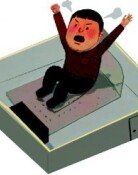Gentrification and Korail Retail
Gentrification and Korail Retail
Posted October. 20, 2017 07:56,
Updated October. 20, 2017 08:56
It was former U.S. President Lyndon Johnson's visit to Korea in 1966 that triggered the transformation of Sogong-dong area in front of the Seoul City Hall into what it is today. The welcoming ceremony for the U.S. president held in front of the city hall was broadcast live nationally and across the world. What was also shown on TV was the impoverished neighborhood around the city hall. Watching the scene on TV, Korean emigrants in the United States filed petitions to the Korean government asking for a renewal of the area. This was the beginning of the first urban renewal work in Korea. As a result, however, Chinese emigrants who had been running Chinese restaurants for generations in the region had to be displaced to other regions.
Gentrification is a global phenomenon where original residents are displaced to cheaper areas once a urban renewal project takes place. In June, an inferno tore through Grenfell Tower in London, which was a ghetto of impoverished immigrants from the Middle East. In Berlin, Germany, the central and local governments are controlling a rise in house-rent by imposing fines to landlords who break the law. But this is only a stop gap measure as long as lack of housing supply is not resolved. A rise in house-rent and displacement of residents are side effects of urban renewal projects.
Gentrification is a term coined by British sociologist Ruth Glass in 1964 to describe the influx of middle-class people displacing low-income residents in the western London regions. Some say reason Glass viewed the middle-class as landed-gentry and saw gentrification as a conflict between classes was because he was a Marxist. The National Institute of Korean Language refined the term to "Doongji Naemollim," which means being forced out of one's nest. Whether it is original residents, small shopkeepers or poor artists who are being forced out of a neighborhood, gentrification takes away the feeling of warmth from people and narrow alleys.
Recently, a store selling fish cake on the second floor of the Busan Station was unable to bear the expensive rent and eventually closed its business. According to the contract, the store gave 25 percent of its sales to the Korail Retail, and paid almost 3.8 billion won as a rent last year. The net profit of a fish cake store was hardly likely to exceed 25 percent of its sales. The Korail Retail requires 550 stores at railway stations across the country to pay their rent according to their sales. It is only a matter of time before another store goes out of business due to a burdensome rent.







